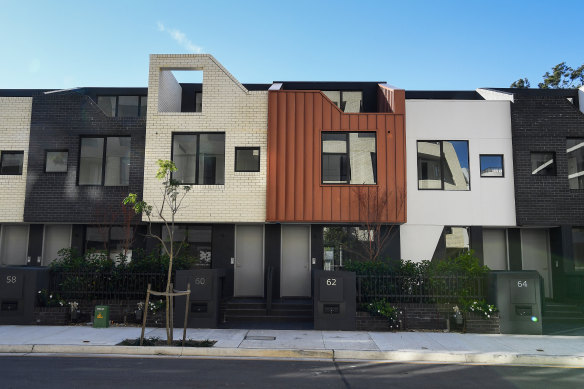- Exclusive
- National
- NSW
- Housing affordability
This was published 11 months ago
Revealed: The ‘missing middle’ Sydney housing changes delayed until after council elections
The state government has been urged to “get on” with its key housing reforms after revelations it has delayed the bulk of its low- and mid-rise planning changes until the end of this year – after the looming council elections.
While the first part of the reforms began this week, enabling dual occupancies and semi-detached dwellings across most of NSW, the second stage – allowing more terraces, townhouses and small apartment blocks near transport hubs and town centres – will now commence “later in 2024”.

The kind of modern terrace housing envisaged by the low- and mid-rise planning reforms, most of which have been delayed until the end of 2024.Credit: Kate Geraghty
That meant the tail end of the year, according to government sources involved with the policy but not authorised to speak publicly. The government previously said it intended the whole package to “take effect by the end of June 2024”.
The state’s councils enter caretaker mode on August 16 before elections on September 14 that will alter their elected personnel and political make-up, potentially affecting deals already under way.
The latest delay follows the earlier deferral of several transport-oriented development sites, which were initially due to begin in April to allow councils more time to do their own planning.
Planning Minister Paul Scully did not directly answer questions about when the remainder of the low- and mid-rise program would commence other than to say it would be “in 2024”.
The scheme is especially significant as it applies to far more areas than the transport-oriented changes and is predicted to deliver up to 112,000 additional homes over the five years of the National Housing Accord – for which the clock started ticking on Monday.
Consultation on the package took place over the summer. The Planning Department has since sifted through hundreds of train stations and “town centres” across Sydney, the Hunter and the Illawarra, which could trigger the zoning changes.
Many councils have rejected the policy in its entirety, and pushed back on some or all of the suggested sites, saying they lack regular bus services, large enough supermarkets, or the road capacity to accommodate more housing.
On June 21, North Sydney Council chief executive Therese Cole wrote to Planning Department secretary Kiersten Fishburn to reiterate the council’s “strenuous objection” and rejected all 14 proposed triggers in the North Sydney LGA.
That included town centres in Cammeray, Cremorne, Crows Nest, Milsons Point and Neutral Bay. Cole also retracted an earlier form sent by council staff indicating Neutral Bay was acceptable for inclusion. This was “not duly authorised”, she said.
However, North Sydney Mayor Zoe Baker said she was confident the council could meet the target set for it – 5900 new homes by 2029 – through its own planning, even though the figure was “very much higher than we were expecting”.
“People will accept quite devastating impacts to their own amenity for the public good,” she said. “But you’ve got to do that transparently and together, not just lump it down.”
The government has always offered councils the opportunity to do their own alternative planning, with the state’s reforms a proverbial sword of Damocles hovering over them if they failed. But because the new housing targets were only released four weeks ago, councils argued more time was necessary.
Scully noted that the government reached an agreement with 12 of 13 councils affected by the transport-oriented changes and was now following the “same approach” with the forthcoming low- and mid-rise reforms.
Former Labor housing minister David Borger, who now runs the lobby group Housing Now, said planning reform was always a bumpy road, but “in a crisis, people want to get on and get these projects moving”.
“The fact the government keeps committing to medium-density, the missing middle, is a good thing,” he said. “We’re looking forward to the day when we can actually see more of the terrace housing and walk-up apartment buildings.”
Borger said some Sydney councils could be trusted to do their own planning “as long as it doesn’t slow us down”, but others “I’d be far more circumspect with”.
Woollahra Council, which is Liberal-controlled, also objected to all five proposed triggers for low- and mid-rise housing in its municipality. The council has been tasked with delivering 1900 new homes over five years.
On Tuesday night, Mosman Council acknowledged its new target of 500 homes in five years, which Mayor Carolyn Corrigan said was “reasonable”. Another councillor, Michael Randall, said: “We can live with that … we did get off quite easy with this.”
They defeated a bid to reject the target from councillor Simon Menzies, who suggested exploring a legal challenge over whether Bridgepoint Shopping Centre should count as a full-line supermarket and, therefore, trigger the reforms.
The council’s general manager, Dominic Johnson, told elected representatives they should consider how their actions would be perceived outside Mosman.
“It’s a very ready headline if Mosman goes out and says, ‘We have to deliver 500, that’s outrageous’,” he said. “I don’t think it will achieve anything other than give a whole lot of people even further encouragement to throw rocks at us for not doing our share with what they call the housing crisis.”
Start the day with a summary of the day’s most important and interesting stories, analysis and insights. Sign up for our Morning Edition newsletter.